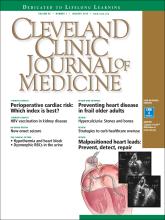Article Figures & Data
Tables
- TABLE 1
The Revised Cardiac Risk Index (RCRI) and the National Surgical Quality Improvement Program (NSQIP) index
RCRI1 NSQUIP2 Factors used History of ischemic heart disease Age History of heart failure Serum creatinine > 1.5 mg/dL History of cerebrovascular disease American Society of Anesthesiology (ASA) class Insulin-dependent diabetes Functional status Preoperative serum creatinine > 2.0 mg/dL Type of surgery Undergoing suprainguinal vascular, intraperitoneal, or intrathoracic surgery Interpretation Low risk
risk factors: 0.4% risk
risk factor: 0.9% riskWeb-based calculator gives a percent risk: www.qxmd.com/calculate/calculator_245/gupta-perioperative-cardiac-risk Elevated risk 2 risk factors: 7% risk > 3 factors: 11% risk Derivation and validation study design Prospective cohort 1989-1994 Historical national database 2007-2008 Single hospital 5,737 patients > age 50 Multicenter (200 hospitals) 46,8795 patients > 16 years old Outcomes assessed Myocardial infarction Myocardial infarction, defined as 1 of the following: ST-segment elevation Cardiac arrest New Q waves Ventricular fibrillation New left bundle branch block Pulmonary edema Troponins > 3 times normal Complete heart block Cardiac arrest Advantages Used for more than a decade Surgery-specific Disadvantages Advanced laparoscopic procedures were not widely performed when this index was devised Coronary artery disease, aortic stenosis are not variables Functional capacity not a variable
Definition of myocardial infarction is based on creatine kinase MB (CK-MB): CK-MB > 5% of total CK, or > 3% of total CK with electrocardiographic changesMyocardial infarctions may have been overdiagnosed due to troponin elevation of unknown significance Only 0.2% patients had severe aortic stenosis, so it is not included






